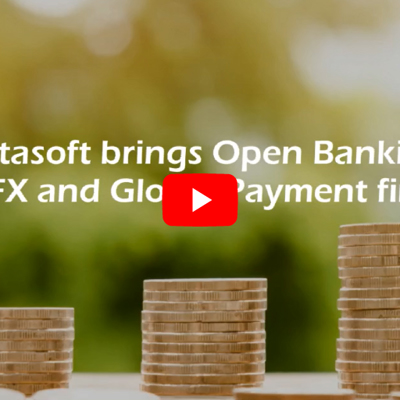The financial services landscape is constantly evolving with companies innovating to make payment and transaction services simpler and more seamless. Financial technology companies (FinTechs) are at the forefront of this innovation and drive, introducing cutting edge products and superior services aimed at making various facets of the industry more efficient. An era of ‘Open Banking’ is already unfolding within the industry; while the concept of open banking is not entirely new, financial services will rapidly change with increasing adoption.
Open banking at a glance
Open banking is a secure technology that enables the sharing of financial information with authorized third-party providers. The concept of open banking is based on the premise that the financial data in the custody of banks and other financial institutions belongs to consumers and they should be able to leverage their aggregated data to make sound investment and financial decisions. Open banking is forming an avenue for a wave of new products and services, seated on consumers individual financial data, to deliver to each consumer more tailored products and services, detailed understanding of their financial health, and more competition.
Legislation in the UK and EU has directed that banks must offer standardized APIs for approved 3rd parties providing Account Information Services (AIS) or Payment Initiation Services (PIS). AIS relates to permissioned access to a customer’s account information data & transactions. PIS enables providers to initiate a payment from an account held by another institution.
AIS propels services like product or price comparisons and advice based on live financial data. This includes functionality such as spending, budgeting, and investment advice. PIS ultimately makes transactions across institutions far simpler. For example, arranging a bank transfer rather than being limited to cards or direct debit.
It is important to note that consumers will still determine what data they are willing to share and for how long they are willing to share it. Traditional banks have long enjoyed exclusivity to the data of their customers and open banking will change the narrative reshaping the competitive landscape and consumer experience.
Many countries are refining or drafting regulations around open banking. The U.K, Australia and the European Union are the front-runners while in Canada, the Department of Finance continues to make progress towards adoption. The critical areas being reviewed include how it will enhance the financial system and competition without jeopardizing data privacy and security.
What are the benefits of open banking?
Open banking promotes competition and drives transparency with customer-centric products and pricing. Opening banking is going to impact consumers and financial services in several ways including:
- With permissioned access to consumer data, FinTechs will continue to deliver ground-breaking applications. This innovation momentum is just beginning and will reach far beyond what traditional banks currently offer.
- FinTechs will deliver more intelligence to Consumers by leveraging live consumer data from multiple financial channels. Consumers will benefit from more financial intelligence support delivering better spending and budgeting controls to savings and investments tools.
- Companies or financial services that offer credit and rely on creditworthiness of consumers can better visualize the financial picture of individuals and businesses which will strengthen credit risk frameworks.
- Having the ability to confirm the existence of bank accounts can strengthen Know-Your-Client and compliance regimes to digitize new customer onboarding. Access financial data can also help detect fraud, money laundering and tax evasion.
Risks of open banking
Open banking has many benefits but poses severe privacy risks. Such risks are even more potent when dealing with customer finances and financial data.
At a broader level, open banking is materially going to change the financial services landscape. While an increase in competition favors consumers, there is the potential of industry consolidation from the depletion of revenues from traditional financial services. Critics worry about the negative effects of consolidation on consumers such as privacy and anti-competitive consequences. Similar comparison being made are concentrated search engines and social media giants where the present and future consumer benefits are increasingly coming into question.
Regulatory frameworks aim to overcome these risks; in this modern era where data privacy and protection are commonplace, open banking will extend and test existing risk mitigation principles and law.
FX and Global Payment firms in an open banking era
FX and Global Payment firms are using open banking to improve internal processes and at the same time are evolving to deliver an open architecture for the benefit of their customers.
Compliance frameworks of MSBs and NBFIs who send or receive third-party payments is especially onerous yet necessary. To win the trust of banking partners and payment rail providers, putting forth a robust identity verification regime is a vital ingredient. Open banking has quickly become an asset in customer onboarding programs. Using Account Information Services (AIS) to instantly access customer’s account information data as a means of identity verification, NBFIs can digitize their know-your-client processes and quickly approve new customers with far less friction. Open banking AIS is also propelling credit risk management for FX firms. For instance, for firms that do not (or partially) collateralize FX forwards, open banking can immediately establish the amount of cash the customer has, and accordingly grant FX forward facilities and limits. Another application of open banking AIS is managing recourse risk and insufficient funds for preauthorized debits. AIS provides for a drastic reduction of risk where the NBFI can quickly verify whether the customer has sufficient liquidity prior to requisitioning the ACH debit or PAD.
The adoption AIS to aid compliance and credit risk processes is a beginning of what inevitably will become more innovation, automation and efficiency as open banking takes root.
At the same time, NBFIs have a brilliant opportunity to themselves provide open access to their customers. There are already several success stories of open architecture from providing API-driven live FX pricing and execution; foreign/domestic payment initiation services via API; and API-based hedging automation. This open architecture continues to grow opportunity and improve digital revenues streams for NBFIs. Some recent opportunities seen are providing white-labelled payment rails and FX pricing and execution to FinTechs that serve a broader market. For example, tools for international students and educational institution treasuries; cross-border crowdfunding outfits; cross-border ecommerce and more.
NBFIs that include open architecture in their service offering will put themselves in a position to capitalize on the inevitable paradigm shift open banking is bringing.
For more information visit www.datasoft.global







